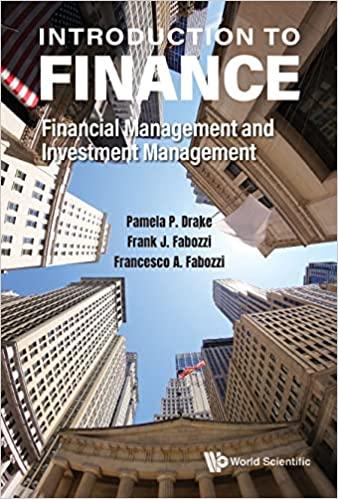Question
URGENT 1. Which of the following statements is correct? Please explain and justify your choice. A) The delta of a short position in an at-the-money
URGENT
1.Which of the following statements is correct?
Please explain and justify your choice.
| A) The delta of a short position in an at-the-money European call is 0.5. | ||
| B) The delta of a short position in a European put is between 0 and 1. | ||
| C) The vega of a long position in an option increases as we move away from the money. | ||
| D) The gamma and the vega of a long position in a European call is negative. |
2.Which of the following statements is correct?
Please explain and justify your choice.
| A) As the time-to-expiration increases (all else remaining unchanged), European calls and puts always become more valuable. | ||
| B)Only the buyer of an option has the obligation to post a margin. | ||
| C)All in-the-money American puts have positive intrinsic value, while all out-of-the-money American puts have a zero intrinsic value. | ||
| D)In a bear market, the holder of a put gains more than then holder of a short position in the underlying asset. |
3. Which of the following statements is correct?
Please explain and justify your choice.
| A) A long position in a European call is delta-hedged with a long position in the underlying asset. | ||
| B) A delta-neutral portfolio needs to be rebalanced less frequently as the gamma increases to maintain delta-neutrality. | ||
| C) The delta hedging error increases as the curvature of the relation between the option prices and the stock price increases. | ||
| D) To change the gamma of a portfolio, we need to trade the portfolios underlying asset. |
Which of the following statements is correct?
| A) To estimate implied volatility, we do NOT need to change the arbitrary guess of volatility, when the Black-Scholes option price which is based on our arbitrary guess of volatility is greater than the option price observed in the market. | ||
| B) Implied volatility decreases as option prices increase. | ||
| C) Implied volatility is backward looking, i.e. standing at time t, it is the expected volatility under the real probability measure between t and (t - T), where T is the time-to-maturity. | ||
| D) According to Black-Scholes implied volatility should be constant across both the strike price K and the time-to-maturity T. |
Step by Step Solution
There are 3 Steps involved in it
Step: 1

Get Instant Access to Expert-Tailored Solutions
See step-by-step solutions with expert insights and AI powered tools for academic success
Step: 2

Step: 3

Ace Your Homework with AI
Get the answers you need in no time with our AI-driven, step-by-step assistance
Get Started


